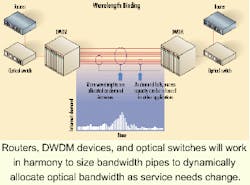Building the intelligent optical Internet
Core networking combines Internet Protocol and the intelligent optical layers for unprecedented customization, management, and service differentiation.
Steve AlexanderCiena Corp.In a world where user-friendly, simple point-and-click technology has come to be expected, the high-speed core of today's public network should be no more complicated to work with than the World Wide Web. When modern-day PC users connect to the Internet, they are basically initiating a transaction through an easy-to-use interface. The network itself translates the text-format URL into an Internet Protocol (IP) address, negotiates a series of connections with routers and servers in the network, then delivers the requested data. The user does not have to think about bandwidth, interfaces, routers, or paths.
There is no reason the same model cannot apply to provisioning bandwidth in the network backbone. This model is what you might call the "intelligent optical Internet," a seamless, interoperable network of high-speed, high-capacity routers, transport systems, optical switches, and software that can dynamically self-provision any amount of bandwidth anytime according to immediate customer needs.
If you look at the LAN today, in the home or the enterprise, you can see that it basically works the same way. There is no reason why that model cannot be reflected out into the core of the network.
What that means is an end to reliance on proprietary equipment and a move toward adoption of open platforms and protocols. Of these, IP holds the greatest attraction because it is a robust, proven standard in data communications. Add to that the greater and greater number of wavelengths that can be placed on a single fiber, and the emerging power of intelligent optical switching and a significant new platform for future network growth begin to take shape.
The problem with current legacy infrastructure in the core is that it is neither interoperable nor scalable. Although promised for a long time, true functional "mid-span" connections between vendor transmission equipment in the public network never materialized.
IP, however, is demonstrably interoperable. For years, routers and servers from different manufacturers have been easily passing content and signaling to one another. The challenge is to migrate that interoperability into the optical core. A carrier should be able to activate a router, switch, or terminal and instantly have it recognized and interacting with the network as a whole.Secondly, the current legacy network forces carriers to manually provision their bandwidth, creating immense problems when it comes to responding to and managing the insatiable demand for bandwidth. Today, for example, if a carrier gets an order for a 655-Mbit/sec connection between Washington, DC, and San Francisco, the carrier must go to each ring, manually pick out an OC-12, then connect it ring by ring across the country. There are dozens of people on staff, perhaps even hundreds, at each carrier whose sole job is to work on finding, linking, and provisioning these trunks. The staff may direct, but technicians from all across the country must also be involved. Trucks have to roll. As a result, fulfillment is measured in weeks and months.
The voracious demand for bandwidth, let alone competition between service providers and carriers, increasingly makes this method too costly and cumbersome. In the long run, it will simply prove unworkable.
Carriers need a way of allocating bandwidth virtually. As opposed to manually connecting trunks, they must be able to assign wavelengths and connections using a simple point-and-click interface on a workstation, which is what enterprise networks do today. Provisioning is thereby accomplished in minutes.
The first carrier to offer virtual allocation of bandwidth will take as monumental a step as Sprint did when it unveiled its all-digital fiber-optic network with the image of a pin dropping. That one little pin immediately forced the other carriers to write off their analog networks. Just think of what will happen when the first carrier using intelligent optical networking takes out a full two-page newspaper ad that says, "Buy bandwidth from me, and I'll get it to you in minutes!" On that day, everything in optical networking will change.
Why? Because the intelligent optical Internet concept truly gives carriers the power and control they have been seeking for years. It suddenly gives them the credibility of being creative, speedy, and responsive backbone providers. And because the intelligence is all contained in software and silicon, backbone providers can use specialized toolkits to craft more differentiated services for a diverse customer base. They will become service providers in every sense of the word, not merely pipeline companies that offer the same increments of raw bandwidth to all comers.
This advancement is important, because there already seems to be an inevitable shift in the makeup of the service-provider business. While at one time they could be grouped into discrete classes, such as local and long-distance, the Internet and class-independent next-generation networks have created new niches and classifications based on targeted customers, not geography, infrastructure, or distance. To be successful, the backbone provider will have to offer bandwidth and bandwidth-management packages suited to each niche of class.
For example, there will be premium high-end carriers that offer mission-critical network services to corporations. They will want to offer various grades of service-platinum, gold, silver, and bronze-that give greater or less priority as required. Then there will be low-end dial-around resellers offering inexpensive voice-over-IP long distance. They may want only basic best-effort service.There will be middlemen who buy 1 Gbit/sec of bandwidth and resell it in chunks to other carriers or Internet service providers (ISPs). There will be layers of international, national, and regional service providers and ISPs with a slew of different needs. Not all carriers want to buy in DS-3 increments.
Today, core network providers are creating infrastructures that have dynamic optical services that can meet the specific needs of all these customers.
This intelligent optical Internet requires close cooperation between the IP and optical layers, and both of these layers should soon be coming together and interacting through common signaling, as opposed to IP simply riding an optical layer.
Today, the industry is close to the point where optical bandwidth can be virtually provisioned through workstations. With the integration of signaling, the entire core network can be self-provisioning.
Just like today's Internet user, the network, when addressing a specific service request from a user or service provider, will automatically request, assign, and use the required bandwidth. That's accomplished solely by the interaction of the infrastructure itself, using IP open-signaling protocols common to all network equipment. The network, in essence, becomes self-provisioning.
While the open-network model is well established in data-communications circles, in the carrier world, it is a relatively new concept. But there are no technical barriers, just old habits to overcome. Carriers have the fiber-optic capacity in place, and people simply just have to go out and do it.
The first carriers have begun to make their moves, and we should see rudimentary versions by year's end. Even though not all the work on signaling standards has been completed, carriers will be looking to see how the platform plays out in the network.
How do carriers get started? First, they must stop deploying additional legacy switching and transmission equipment. That only adds to overall capital and operating costs. Next, they must begin to deploy the intelligent optical switches with direct connections to IP routers. With the addition of embedded intelligence within these systems, carriers can begin to move toward creating next-generation optical services.
Legacy equipment needs not be discarded or written down. Indeed, carriers have the choice of riding out the investment to full depreciation. However, the intelligent optical Internet model is the only way carriers will be able to handle the explosive growth in bandwidth demand expected in the next few years.
The bandwidth in today's network will account for only 1% to 10% of the total bandwidth of the network in five years. That 10% portion of the network can remain equipped with legacy gear, but service providers would do well to view it as only a small part of the greater whole. Compare a PC upgrade, where an owner takes the data that fills a 100-Mbyte disk and places it in a folder that takes up just a small part of a new 1-Gbyte drive.
What carriers need is a strategy that helps them grow. And the intelligent optical Internet, with its dynamic bandwidth provisioning, software-defined service toolkits, and ultimately, seamless interaction with IP signaling, is the way to go.
Steve Alexander is senior vice president and chief technology officer at Ciena Corp. (Linthicum, MD).



